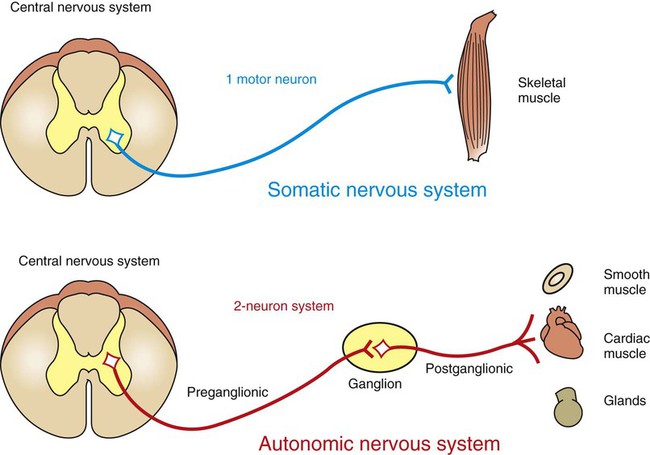

One causes heart rate to increase, whereas the other causes heart rate to decrease. For example, the heart receives connections from both the sympathetic and parasympathetic divisions. At each target effector, dual innervation determines activity. Homeostasis is the balance between the two systems. The sympathetic system is associated with the fight-or-flight response, and parasympathetic activity is referred to by the epithet of rest and digest. The two divisions of the autonomic nervous system are the sympathetic division and the parasympathetic division. In addition to the endocrine system, the autonomic nervous system is instrumental in homeostatic mechanisms in the body. The autonomic nervous system regulates many of the internal organs through a balance of two aspects, or divisions. The somatic nervous system is associated with voluntary responses (though many can happen without conscious awareness, like breathing), and the autonomic nervous system is associated with involuntary responses, such as those related to homeostasis. The autonomic nervous system controls cardiac and smooth muscle, as well as glandular tissue. The somatic nervous system causes contraction of skeletal muscles. The major differences between the two systems are evident in the responses that each produces. The nervous system can be divided into two functional parts: the somatic nervous system and the autonomic nervous system. Describe the signaling molecules and receptor proteins involved in communication within the two divisions of the autonomic nervous system.Explain the differences in output connections within the two divisions of the autonomic nervous system.Name the components that generate the sympathetic and parasympathetic responses of the autonomic nervous system.Most organs/tissue are innervated with sympathetic ganglia.By the end of this section, you will be able to: The SNS can also be thought of as the “E division” – embarrassment, emergency, exercise, and excitement. Sympathetic Nervous System – “fight or flight” Muscarinic receptors – GPCRs located on effector/end organs.Nicotinic receptors – ion channels located on ganglia.Waste elimination – defecation and urinationĪcetylcholine interacts with two types of receptors:.Increased digestion – increased GI motility and secretions.Energy storage (glycogenesis, lipogenesis) – lower energy demand at rest.Decreased cardiac output (compared to sympathetic) – lower oxygen demand when at rest.Most organs/tissues are innervated with parasympathetic ganglia.ĮXCEPTIONS – most blood vessels and all sweat glands only have sympathetic innervation.


The PNS can also be thought of as the “D” division – defecation, digestion, and diuresis. Parasympathetic Nervous System Parasympathetic Nervous System – “REST AND DIGEST” For the latter, acetylcholine and norepinephrine are released from postganglionic parasympathetic and sympathetic neurons, respectively. The ANS involves two steps of neurotransmission one at the ganglia (where acetylcholine serves as the neurotransmitter for both the sympathetic and parasympathetic nervous systems) and another at the innervated organs. The SoNS involves one nerve ganglion that communicates with the skeletal muscle. Reminder: NAChR is an ion channel coupled receptor. Once depolarized, the presynaptic neuron releases ACh, which goes on to stimulate the nicotinic receptor on the postsynaptic neuron. The image below is an example of cell-to-cell communication. Two important neurotransmitters are involved in the activity of the autonomic system: acetylcholine and noradrenaline, more commonly known as norepinephrine. Neurotransmitters, or chemical messengers, allow for cell-to-cell communication within the nervous system. Effector Organs – organs on which nerves from the autonomic and somatic nervous systems act.Somatic Nervous System – voluntary nervous system that controls via skeletal muscles.Autonomic System – involuntary nervous system composed of two divisions the sympathetic and parasympathetic nervous systems.Peripheral Nervous System – composed of nerves outside of the brain and spinal chord including the afferent division (sends messages to CNS) and efferent division (sends messages away from the CNS).



 0 kommentar(er)
0 kommentar(er)
